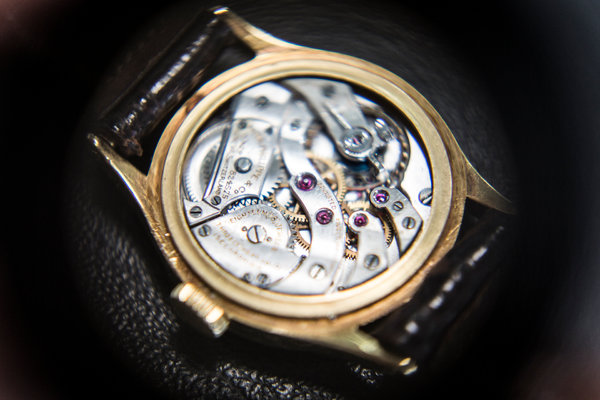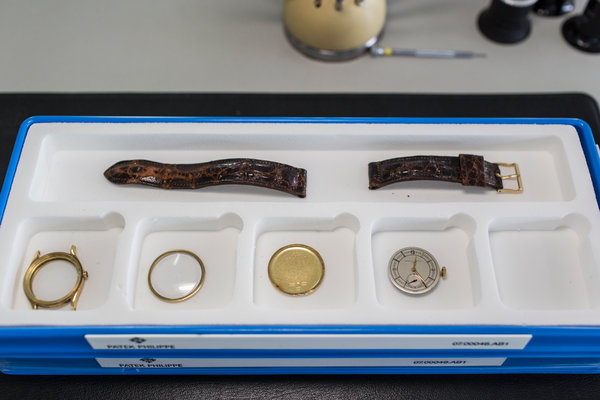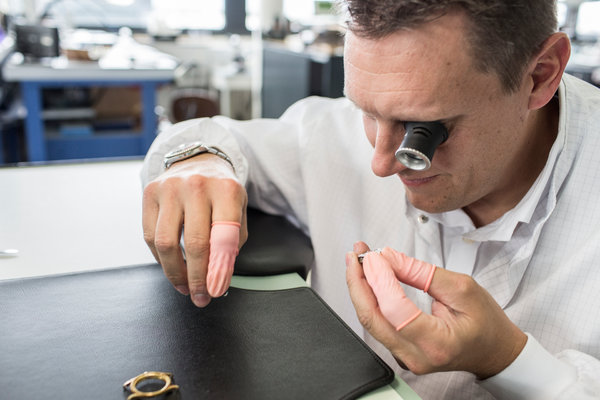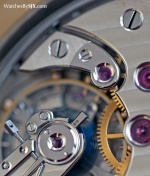ZEN
Rang: Administrateur

Nombre de messages : 57505
Date d'inscription : 05/05/2005
 |  Sujet: Actu: Patek Philippe and Me Sujet: Actu: Patek Philippe and Me  20/12/15, 08:13 am 20/12/15, 08:13 am | |
| A découvrir - Citation :
PLAN-LES-OUATES, Switzerland — I had known for years that my husband had a Patek Philippe watch.
I never saw it, because he kept it in the back of a drawer. Every now and then I would say, “You really should get it conditioned and start wearing it. Life is short.” We couldn’t know how true that would be; Steven died in 2011.
Patek Philippe, the legendary Swiss watchmaker founded in 1839, boasts that it can repair any of its watches — no matter how old, no matter how rare. The company keeps an extensive archive of parts, old and new, and if it does not have parts in stock any more, members of the staff can recreate them.
The repairs also have the reputation of being very, very expensive.
I thought I would put Patek Philippe to the test, and that is how I came to be standing in its clinically modern, all-white headquarters in Plan-les-Ouates, on the outskirts of Geneva, with the watch in my hand.

Ms. Beckett's watch: A Patek Philippe Calatrava, first sold in 1937. Credit Pascal Mora for The New York Times
But, he continued, no one in a store “is allowed to touch the movement.” For that, the watch must be sent to one of 55 service centers in 35 countries around the world.
“My job is to make sure that all the watchmakers around the world work exactly the same,” Mr. Lemmelet said. “It can take 15 years to be a watchmaker. The watchmakers come back here every three years to refresh their knowledge” and, with additional training, rise up the ranks.
And watches with complications such as a tourbillon or minute repeater — or any watch produced before 1971 — can only be serviced in Geneva. My husband had inherited the watch from his father, and that meant it was probably made between 1930 and 1950. So my watch would have to go home.
When Patek Philippe receives a watch for servicing, the staff’s first step is to authenticate it.
A staff member placed my watch in a blue plastic box labeled with the numbers engraved on its case and on its movement. And I was ushered into a room where two workers, Christel and Alessia (company policy restricts identification of workers to first names only), sat in front of computers.
Advertisement
Continue reading the main story
Photo

The watch, dismantled for inspection. Credit Pascal Mora for The New York Times
They have access to company records of every Patek Philippe watch ever made — which, for older ones, involves images of ledger pages handwritten in sepia ink — and make sure the numbers on the watch match the numbers in the ledgers. Between them, they check 35 to 40 watches a day.
When Christel entered my watch’s numbers, a page popped up. I could see that it originally was sold on March 30, 1937, in New York to a P. Wise, which we decided must have been a dealer. I felt like I had discovered a long-lost relative on Ancestor.com.
My watch, an early Calatrava model — the first came out in 1932 — features an extremely rare face, which I had learned earlier by doing some research. Jean-Marc Thomas, the international customer service manager, who accompanied me throughout the day, announced: “It’s a real Patek Philippe,” and I sat up a little straighter.
Advertisement
Continue reading the main story
@charset "utf-8"; /* CSS Document */ @font-face {font-family: "CheltenhamBT-BoldHeadline"; src: url('http://d3cxgjorprur2q.cloudfront.net/campaigns/campaign_818/creative_1052/CheltenhamBT-BoldHeadline.otf');} @font-face {font-family: "FranklinGothic-Book"; src: url('http://d3cxgjorprur2q.cloudfront.net/campaigns/campaign_818/creative_1052/FranklinGothic-Book.otf');} @font-face {font-family: "FranklinITCExpertBQ-MediumS"; src: url('http://d3cxgjorprur2q.cloudfront.net/campaigns/campaign_818/creative_1052/FranklinITCExpertBQ-MediumS.otf');} afp_hidden { -ms-filter: "progid:DXImageTransform.Microsoft.Alpha(opacity=0)"; filter: alpha(opacity=0); opacity:0; } .afp_visible { -ms-filter: "progid:DXImageTransform.Microsoft.Alpha(opacity=100)"; filter: alpha(opacity=100); opacity:1; } #afp_1052_701660_wrapper { width: 300px; height:264px; background-color: white; /*position: relative; */ z-index: 999999999; -webkit-touch-callout:none; -webkit-user-select:none; -webkit-text-size-adjust:none; cursor:pointer; /* -webkit-transition: all 1s ease-in-out; -moz-transition: all 1s ease-in-out; -o-transition: all 1s ease-in-out; -ms-transition: all 1s ease-in-out; transition: all 1s ease-in-out; */ } /* --- UNEXPANDED ------------------------------- */ #afp_1052_701660_unexpanded { width: 300px; height:264px; position: absolute; left: 0px; top: 0px; overflow: hidden; border: 1px solid #ced6d8; box-sizing: border-box; -webkit-transition: all 0.5s ease-in-out; -moz-transition: all 0.5s ease-in-out; -o-transition: all 0.5s ease-in-out; -ms-transition: all 0.5s ease-in-out; transition: all 0.5s ease-in-out; } #afp_1052_701660_image { width:300px; height: 212px; position: absolute; top:0; left:0; display: block; background-position: center top; background-size: cover; } #afp_1052_701660_sponsored { position: absolute; right: 18px; top: 16px; font-family: "FranklinITCExpertBQ-MediumS"; font-size: 12px; color: white; text-transform: uppercase; background-color: rgba(234,59,27,0.7); padding-top: 10px; padding-bottom: 5px; padding-left: 15px; padding-right: 15px; cursor: default; border-radius: 3px; display: none; } #afp_1052_701660_txt1 { position: absolute; left: 11px; top: 207px; font-family: "FranklinGothic-Book"; font-size: 11px; color: #929292; text-transform: uppercase; cursor: default; display: none; } #afp_1052_701660_txt2 { position: absolute; left: 11px; top: 225px; font-family: "CheltenhamBT-BoldHeadline"; font-size: 20px; color: black; cursor: default; display: none; } #afp_1052_701660_txt3 { position: absolute; left: 84px; top: 220px; font-family: "nyt-cheltenham-sh",georgia,"times new roman",times,serif; font-size: 0.875rem; font-weight: 700; color: black; cursor: default; height: 17px; overflow: hidden; } #afp_1052_701660_txt4 { position: absolute; left: 84px; top: 240px; font-family: georgia,"times new roman",times,serif; font-size: 0.8125rem; font-weight: 400; color: black; cursor: default; height: 17px; overflow: hidden; } #afp_1052_701660_logo { position: absolute; left: 0px; top: 220px; width: 75px; height: 35px; background: url(http://d3cxgjorprur2q.cloudfront.net/campaigns/campaign_818/creative_1052/sothebys_logo.png) no-repeat; } /* --- END OF UNEXPANDED ------------------------- */
The watch was photographed, front and back, and then was put back in its box. Next, we went down some long corridors to the restoration workshop, a pristine and well-lighted room where 11 men and three women wearing white smocks sat at desks with dozens of tiny tools within their reach.
This is where Roman, the restoration workshop manager for older watches (there is a separate workshop for watches made after 1971), opened my watch. It is a delicate operation, as opening a watch improperly can dent its case, or worse.
Roman began to tell horror stories and showed me before-and-after photos: Someone glued a dial onto a movement. Someone else tried to use a paper clip to open a case and gouged the back. Movements have been destroyed by oxidation, rusted beyond recognition — but not beyond repair. There is nothing Roman and his team cannot fix, even though, working by hand, it can take months.
Roman put a little pink rubber tip on his thumb and another on his forefinger, lifted my watch and, like opening an oyster shell, popped off the back of the case to expose the movement. He handed me a loupe. I probably should have gotten all giddy seeing the gears, but what caught my eye were four little rubies on the back of the movement, and I was told there are even more on its front.
Photo

A Patek artisan checks the interior of Ms. Beckett's watch. Credit Pascal Mora for The New York Times
Once the case and movement were separated, the case was sent off to be cleaned. Eva, who heads that division, explained that there are 10 different “activations” of cleaning. I saw a few in progress: an ultrasonic cleanser; a laser machine repairing scratches on a gold case; and a pocket watch placed in a basket and dipped in liquid, not unlike how McDonald’s makes fries.
The department also handles polishing, although an expert had warned me not to get my watch polished.
“It’s the choice of the customer,” Mr. Thomas explained, “but each time we polish we take off some material. By the third or fourth time, the watch won’t have the same look.”
And, he continued, a watch should not need polishing if it has been taken care of properly. “Our philosophy is to maintain, not change,” he said. “It’s as if you have a Rolls-Royce, you don’t paint it when it gets old because you’ve maintained it properly.”
Back at the restoration workshop, where I was promised that the movement would be made good as new, Mr. Thomas led me to an alcove filled with old wood cabinets, looking like a European pharmacy. Each drawer is labeled with a caliber name, going back to 1839. Mr. Thomas pulled out a drawer that was filled with the hundreds of tiny pieces that make a watch tick.
“This,” he said, “is the richness of Patek Philippe.”
Each of the watchmakers has a speciality, such as Franck, who is the master of pivotage. By eye, and just using a hand lathe, he can cut two microns off a pinion, or the axis, of a wheel that already is as slender as a hair. In his 21 years working at Patek Philippe, he said, he had made 4,300 movements by hand. Two apprentices sit at this side, learning the craft.
The last stop was selecting a new band. My watch did not have its original one; the buckle, I was told, was not even real gold. (I hung my head.)
Mr. Thomas introduced me to Chantal, who pulled out tray after tray of choices. There was lavender sateen, crimson cowhide, a grosgrain in blue so delicate it looked like snowfall.
I asked Mr. Thomas for his advice, and he suggested a traditional shiny black crocodile. Then I asked the price; “Oh, about 300 or 400 francs.”
About $300 to $400. I knew I was in over my head.
I spent about six hours at the headquarters that day, and about five days later, received a diagnosis and an estimate.
The rumors were right: it is expensive. Franck would have to work his pivoting magic, the total repair time would be six months, and the cost — 11,500 francs, or $11,425.
Patek Philippe is holding onto the watch while I think about what to do. I’ve pretty much decided to sell the watch, so I want to consult with some other professionals to determine whether I could recoup the cost of repairs at sale time.
I have three months to decide. I hope I don’t become one of the few Patek Philippe customers who look at the estimate, faint and then ask that their watch be returned. But time will tell. http://www.nytimes.com/2015/11/27/fashion/patek-philippe-and-me.html?_r=0
_________________
Contraria contrariis curantur. (Les contraires se guérissent par les contraires).
|
|
Kèyz
Animateur

Nombre de messages : 856
Age : 31
Localisation : Genève
Date d'inscription : 01/11/2014
 |  Sujet: Re: Actu: Patek Philippe and Me Sujet: Re: Actu: Patek Philippe and Me  20/12/15, 10:46 am 20/12/15, 10:46 am | |
| |
|
